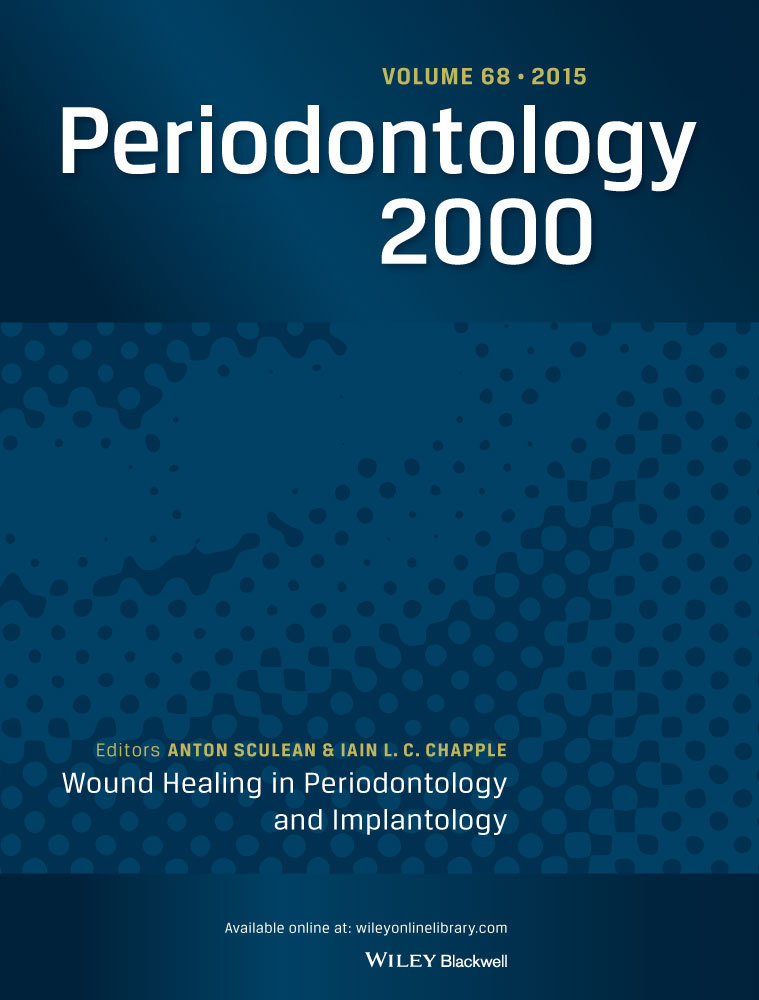Impact of soft tissue augmentation procedures on esthetics and patient satisfaction in the treatment of peri-implant buccal soft tissue dehiscences: A systematic review and meta-analysis.
IF 15.7
1区 医学
Q1 DENTISTRY, ORAL SURGERY & MEDICINE
引用次数: 0
Abstract
The aim of this systematic review was to assess the performance of soft tissue augmentation (STA) procedures, with or without a modification of the prosthetic rehabilitation, for the treatment of buccal peri-implant soft tissue dehiscence (PSTD) in terms of esthetics and patient-reported outcomes. A systematic review protocol was developed following the PRISMA checklist. Electronic and hand searches were conducted to identify randomized clinical trials (RCTs) and prospective studies on the treatment of buccal PSTD in implants without peri-implantitis, with a follow-up of at least 6 months. Professional assessment of esthetics and self-reported patient satisfaction were considered the primary outcomes, while clinical variables were considered secondary outcomes. Meta-analysis was carried out when possible using a fixed- or random-effect model. Eight publications reporting on five studies (two RCTs and three prospective studies), published from 2013 to 2024 and including a total of 87 patients, were included in this systematic review. All studies evaluated a coronally advanced flap (CAF) with connective tissue graft (CTG) or substitutes, whereas one arm of an RCT employed a tunnel procedure. Two studies included changing of the prosthetic component. Three studies were rated at low risk of bias. A total of 10 meta-analyses were performed. STA using CAF achieved a final professional esthetic score of 7.7 on a 0-10 scale (95% CI: 6.63; 8.83) and showed improvements in terms of patient-reported esthetics on a 0-100 visual analogue scale (60.8; 95% CI: 46.56; 75.01), with moderate-to-high heterogeneity. The estimated reduction in PSTD depth was 2.2 mm (95% CI: 1.76; 2.69), with an estimated rate of complete PSTD coverage of 71% (95% CI: 59; 82). Based on limited evidence, it can be concluded that STA procedures around implants affected by buccal PSTD appear to positively influence both professional and patient-reported esthetics outcomes.软组织隆胸手术对口腔种植体周围软组织裂治疗的美学和患者满意度的影响:系统回顾和荟萃分析。
本系统综述的目的是评估软组织增强术(STA)在治疗颊种植体周围软组织开裂(PSTD)的美学和患者报告的结果方面的表现,无论是否对假体康复进行修改。根据PRISMA检查表制定了系统审查方案。通过电子和手检索来识别无种植体周围炎的种植体治疗颊PSTD的随机临床试验(rct)和前瞻性研究,随访至少6个月。美学的专业评估和自我报告的患者满意度被认为是主要结果,而临床变量被认为是次要结果。在可能的情况下,采用固定效应或随机效应模型进行meta分析。本系统综述纳入了2013年至2024年间发表的8篇文献,涉及5项研究(2项随机对照试验和3项前瞻性研究),共涉及87名患者。所有的研究都评估了冠状晚期皮瓣(CAF)与结缔组织移植物(CTG)或替代品,而RCT的一个臂采用隧道手术。两项研究包括改变假体成分。三项研究被评为低偏倚风险。共进行了10项荟萃分析。使用CAF的STA在0-10量表上获得了7.7分的最终专业审美得分(95% CI: 6.63;8.83),并在0-100的视觉模拟量表上显示出患者报告的美学方面的改善(60.8;95% ci: 46.56;75.01),具有中高异质性。估计PSTD深度减少2.2 mm (95% CI: 1.76;2.69),估计PSTD完全覆盖率为71% (95% CI: 59;82)。基于有限的证据,我们可以得出结论,受口腔PSTD影响的种植体周围的STA手术似乎对专业和患者报告的美学结果都有积极的影响。
本文章由计算机程序翻译,如有差异,请以英文原文为准。
求助全文
约1分钟内获得全文
求助全文
来源期刊

Periodontology 2000
医学-牙科与口腔外科
CiteScore
34.10
自引率
2.20%
发文量
62
审稿时长
>12 weeks
期刊介绍:
Periodontology 2000 is a series of monographs designed for periodontists and general practitioners interested in periodontics. The editorial board selects significant topics and distinguished scientists and clinicians for each monograph. Serving as a valuable supplement to existing periodontal journals, three monographs are published annually, contributing specialized insights to the field.
 求助内容:
求助内容: 应助结果提醒方式:
应助结果提醒方式:


